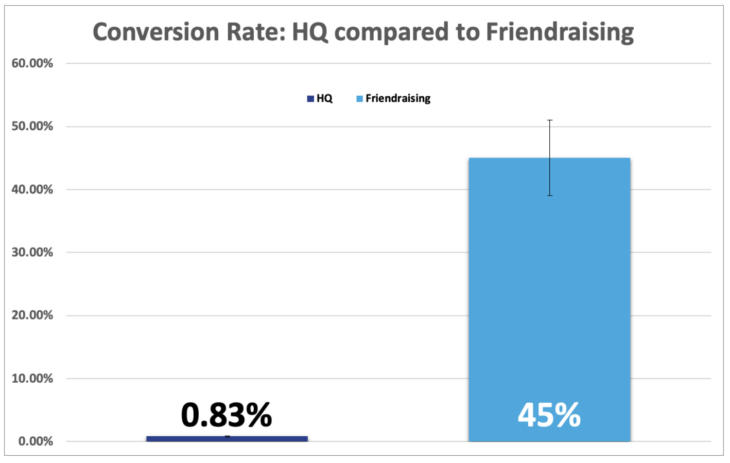Abstract: Sister District Action Network (SDAN) ran this study to explore the efficacy of friendraising, or leveraging personal relationships to raise money for candidates, by comparing two different email message frames, as well as comparing the efficacy of friendraising emails to the efficacy of traditional candidate fundraising emails sent from Sister District Project HQ. In July/August 2020, Sister District volunteers were randomly assigned to send candidate-focused friendraising emails with personalized fundraising links to friends and family (“traditional” emails), or they were asked to send similar personal, self-focused friendraising emails (“personal” emails; see longer report at end for messages). We found that people who received traditional friendraising emails were more likely to donate, and donated more money on average, than people who received personal friendraising emails. We also compared the median donation amounts and conversion rate (how many people donated compared to how many people were emailed) of friendraising emails and candidate fundraising emails sent by Sister District Project HQ. Friendraising emails had both statistically significantly higher median donations and higher conversion rates than HQ emails. This shows outsized fundraising impact for relational organizing compared to traditional methods, and has implications for digital fundraising.
Objective: This study explored the efficacy of friendraising by comparing two different email message frames, as well as by comparing the efficacy of friendraising emails to the efficacy of candidate fundraising emails sent from Sister District Project HQ.
Background: Industry studies indicate that relational organizing, or leveraging preexisting relationships with friends and family to discuss aspects of voting and organizing, is a highly effective tactic. Friends and family are more likely to comply with an ask from someone they know (as opposed to a stranger or an organization). And people tend to have accurate contact information, like phone numbers and emails, for friends and family, as well as a high contact rate when they attempt to get in touch. However, SDAN is unaware of any findings about relational fundraising for political candidates. This study is a conceptual replication with a larger sample of the pilot study SDAN ran last year, which suggested that friendraising emails were more effective than HQ emails, and also that specific fundraising goals were better than abstract fundraising goals.
Specifics: Sister District teams helped to recruit 44 Sister District volunteers for this study. Those volunteers were randomly assigned to send either traditional (candidate-focused) emails or personal (self-focused) emails to friends and family asking them for a specific donation amount. SDAN gave volunteers (“friendraisers”) example emails they could send but they could also write their own. Each wrote the same kind of email (traditional or personal) to everyone they emailed. Each email contained a personalized link, and each link was monitored for a period of about 2 weeks to see how many donors and how much money each friendraiser attracted. Each friendraiser also reported the total number of people they emailed, so conversation rate could be determined (the number of donors compared to the number of people emailed). In order to have a point of comparison, data was downloaded for a candidate fundraising email sent to Sister District volunteers by Sister District HQ distributed during the same time. Overall, 275 people received emails from friendraisers and 42,735 people received the email from HQ. In addition to an original email asking contacts to donate, friendraisers sent a reminder email on/around August 7, 2020. Links were monitored from approximately July 29-August 12, 2020.
Basic Takeaways:
- Friendraising is more effective than HQ emails.
- The conversion rate, or the number of people who donated after being asked, was incredibly high for friendraisers, averaging almost 45%, compared to 0.83% for the HQ email used for comparison. This difference was statistically significant (p < 0.001).
- Traditional candidate-focused emails were more effective than personal message-focused emails.
- The traditional email condition elicited more donations (p = 0.001) and higher donation amounts (p = 0.001) than the personal email condition.
- Conversion rate was significantly higher for the traditional condition than for the personal condition (p = 0.0026). Conversion rates were 52% and 34%, respectively.
- This data suggests that friendraising emails are an incredibly effective relational fundraising approach. Not only do friendraising emails result in a very high conversion rate, they also resulted in higher donations, with a median donation for donors in this study of $50 compared to a median donation for donors of $20.20 for HQ emails (p = 0.0198).
- This data also suggests that the content of such emails should focus on candidate information messages, rather than more personal, non-candidate focused messages.
1) Traditional friendraising emails resulted in more donors than personal emails.
- Traditional emails performed statistically significantly better than personal emails in terms of getting people to donate (p = 0.001). This indicates that people who were sent traditional emails from friendraisers donated more often than people who were sent personal emails from friendraisers.
- The odds ratio for the traditional email condition suggests that people were more than 5.6 times more likely to donate than people who received personal emails.

2) People who received traditional (as opposed to personal) emails donated more money.
- Traditional emails also elicited higher donation amounts (p = 0.001) than personal emails.
- People in the traditional condition donated more on average than people in the personal condition.

3) Friendraising emails have a higher conversion rate than fundraising emails from HQ.
- Friendraising emails have a much higher conversion rate than HQ emails, and the difference in conversion rates was statistically significant in a z test (p <0.001).
- The conversion rate for the HQ email was 0.83% and the average conversion rate for friendraisers (in both conditions combined) was 45%.

- Friendraising emails have a much higher median donation amount among donors than HQ emails, and the difference is statistically significant in a t test.
- Median donation is often a better metric to use than average donation because averages are pulled toward outliers. The median donation for people who donated (omitting people who did not donate) in the HQ email was $20.20 and the friendraising median donation was $50. The t test was significant (t = -2.3373, p = 0.0198), indicating that the friendraising study had significantly higher median donation amounts than the HQ email.
Caveats and considerations:
- Study used a very specific sample. This study used a sample of people who were personal acquaintances of the friendraisers in the study. Also, the volunteers who acted as friendraisiers were willing to do this study and potentially had more possible donors in their personal networks. This means that these individuals were not randomly chosen to participate in the study and that they may have things in common (though we attempted to control for this by using a mixed regression model). This means that this group is unlikely to be representative of the larger population.
- Conditions were not truly randomly assigned. We only randomized friendraisers into conditions, and not the individual people they asked to donate (aka the participants in this study). This means that the actual donors may have had things in common we don’t know about, and so results be not be representative.
- The comparison to HQ is non-experimental. The comparison to statistics from the HQ email is for comparative purposes only. Emails from HQ were not part of the quasi-experiment conducted, and as such, these differences in conversion rate and median donation amount could be explained by a variety of factors that are not currently controlled for in the analysis.
Contributions and Future Directions:
This study continues SDAN’s investigation into relational organizing, and specifically relational fundraising. As relational organizing becomes more popular, results from studies like these will help to guide the most effective approaches. Further, it helps to establish how effective and relatively low lift email fundraising among established personal networks is, and suggests that this could be used as a volunteer activity for folks who would rather not talk to strangers but don’t mind approaching their own social circle.
Future studies should explore other messaging approaches, as well as the effect of anchoring on the specific fundraising goal cited. It may be the case that people who see a larger monetary goal give a larger donation than folks approached with a smaller monetary goal. It is also necessary to determine how to scale such approaches in order to make them effective organizing tactics, so future studies may include ways to easily complete the friendraising email process to determine if more folks are approached when the process is more automated (similar to relational organizing app text messaging approaches that autoload messages into a phone’s SMS app).
While promising, the results described here are not conclusive, and as always, more research is necessary to fully understand the efficacy of friendraising. But initial results are extremely promising, and suggest a lot of utility in using personal networks to accomplish political goals.
If you’re interested in reading more about this study, a longer report is here.
SDAN’s commitment: It is SDAN’s intention to provide as much context as possible to allow for the nuanced interpretation of our data. SDAN’s convention is to contextualize effects by reporting p values, confidence intervals, and effect sizes for all models tested (these items may be in the longer report linked in the blog). Additionally, SDAN always differentiates between planned and exploratory analyses and a priori and post hoc tests, and reports the results of all planned analyses regardless of statistical significance. If you have questions about these findings please email Mallory.

Gaby Goldstein
Gaby is one of the Co-Founders of Sister District, and the Senior Vice President of Strategic Initiatives at Sister District Action Network

Mallory Roman
Mallory is the Director of Research at Sister District Action Network and oversees the day to day operations of SDAN, the organization formed for educational and civic engagement work.



